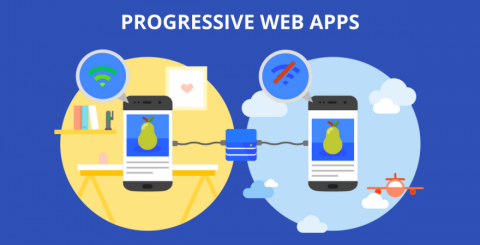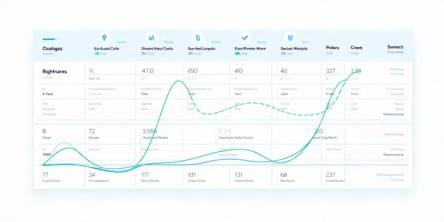Progressive Web Apps: Ticket to the Future of Apps

In 2015, Google Chrome engineer Alex Russell and designer Frances Berriman devised the term "Progressive Web Apps" to describe a new generation of apps that leverage modern features supported by recent browsers. This includes Service Workers and Web Manifests that enable users to upgrade web apps to first-class apps in their native OS
Progressive Web Apps are experiences that bring the best of both worlds - the capabilities of the web and the power of apps. They are beneficial to users from the very first visit in a browser tab, and don’t require any downloads or installation. Users can progressively build a relationship with the app over a period of time and it becomes more useful and powerful with time. Progressive web apps have quick loading times even over flaky networks. They are accessible from an icon on the home screen and load as a top-level, full-screen experience.
But what does a Progressive Web App mean?
A Progressive Web App is one that is:
- Progressive: This means it works for every user no matter what the browser because progressive enhancement is a core tenet.
- Responsive: It fits any form factor from desktop to mobile tablet, and whatever technology enables browsing. Connectivity independent: Enhanced with service workers to work offline or on poor quality networks.
- App-like: Experience like an app, because the app shell model separates the application functionality from application content.
- Fresh: Continuously updated and fresh because of the service worker update process.
- Safe: Secure owing to HTTPS that prevents against snooping and content tampering.
- Discoverable: Is clearly recognized as an "application" thanks to W3C manifest and service worker registration scope, allowing search engines to find it.
- Re-engageable: You can send push notifications to re-engaged users.
- Installable: Lets users add apps they find most relevant to their home screen without the need to access an app store.
- Linkable: Allows easy sharing of the app via URL. It doesn’t require installation or download.
Why Progressive Web Apps?
Research shows that an app loses 20% of its users for every step between the user’s first contact with the app and the user starting to use the app (on an average). Consider the typical steps in the user journey: discovering the app in the app store, downloading it, installing it and getting on board. The beauty of progressive web apps is that the user can start enjoying it immediately eliminating the rest of the stages. A progressive web application uses the best of mobile app’s characteristics, leading to increased user retention and performance without the hassle of maintaining mobile apps.
Use cases: What are some use cases to consider PWA? Native apps are usually recommended for apps that one expects users to return to frequently and a progressive web app delivers on this front. Twitter mobile, Washington Post PWA, Flipboard, FT PWA, 2048 puzzle are well-known examples of progressive web apps.
To decide whether your next app should be a cross platform app, a native app or a progressive web app, you must first identify your users and their most important user actions. Since it is “progressive” it works in all browsers and provides new and enhanced experiences when the browser is updated with improved features and APIs.
If you choose to opt for PWA, then you may have to decide what functionality to offer offline and facilitate the navigation (since there is no back button in standalone mode). PWA works out very well if your website already has an application like interface.
PWA and Cross Platform Technology: PhoneGap recently announced the intention to create compatibility between Apache Cordova and Progressive Web Apps in 2017. This will enable developers to create a PWA app, deploy it on the web, and also compile it for App Store distribution. Developers of PhoneGap are excited with the new possibilities this opens up for them.
Another possibility is to create a mobile lite version wrapped in a native application using any of the several cross platform frameworks like Cordova, React Native etc. This can create an optimal mobile experience across all three platforms –mobile web, iOS native and Android native.
Conclusion:
It is evident that PWA are here to stay and will be adopted widely in the future. They will not replace native or hybrid apps, but provide a creative solution in use cases where you want to bypass app fatigue and where the web-based experience pushes traffic to devices that support more advanced features. For example, AliExpress increased conversion rates for new users by 104%. United eXtra Electronics saw 4x increase in re-engagement and 100% more sales from users arriving via web push. Have you built or used Progressive Web Apps? Please share your experience in the comments section below.
Similar Articles
Food delivery applications, including Uber Eats, DoorDash, Zomato, Swiggy, and Grubhub, generate large volumes of valuable data.
Modern businesses are drowning in communication overload, and much of that burden stems from outdated tools that simply can’t keep up
Building lending software isn’t just a technical project—it’s a business decision. Whether you're a fintech founder or part of a traditional lending institution trying to go digital, three questions will shape everything that follows
Learn why robust security is crucial for super app development. Explore key strategies and best practices for mobile app development security.
Walkie-talkies with an extensive reception capacity have changed significantly when it comes to portable communication by displaying cutting-edge features with seamless connectivity that covers more than just the state
USB-C technology has revolutionized the way we charge our devices, offering faster charging speeds, higher power delivery, and universal compatibility across multiple devices
Discover expert mobile app development strategies to create a viral app that attracts users and boosts engagement
Optimize app localization for iOS users across the EU with language, cultural, and regulatory adaptations. Engage users and boost retention with these tips!
Discover the top 10 mobile app development trends of 2024! Explore 5G, AI, AR/VR, blockchain, and more to stay ahead in the ever-evolving app development landscape.









